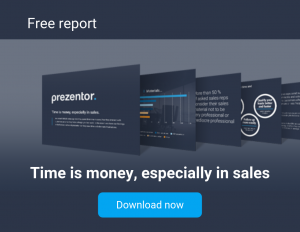A Quick Guide to Improving Sales Efficiency
Sales efficiency is one of the keys to making a business more profitable. In this article, we will explore reasons to care about efficiency and ways to improve it. Having a better strategy helps, but as we will find out, so does using professional and dedicated online tools.
Efficiency is critical in many aspects of our lives. Whether it’s when manufacturers make the products we use, how we distribute the furniture in our house, or the way we manage our busy schedules, efficiency is typically at the centre of it all. We also seek to do more with what we have. To do that, we have to find ways to be more efficient. We interviewed 150 B2B salespeople, and a whopping 93% thought they could improve their efficiency at work.
If we transfer the concept of efficiency to sales, it essentially means to make the most sales using the least amount of money. It could mean to make more sales while maintaining more or less the same costs, or spending less money to make the same number of sales. In a nutshell, better sales efficiency would result in high revenue compared to operating expenses.
Sales efficiency explained
Sales efficiency is the ratio between revenue from sales and the cost of making those sales. This simple formula gives the ratio:
revenue from sales / cost of making those sales = Sales efficiency ratio
As you can expect from this formula, a sales efficiency ratio lower than 1 means that it costs more to generate sales than what the sales actually bring in. If the answer is 1, it means you break even or that your sales bring in exactly what it costs you to produce them. If either of those situations is your case, there is an issue with the sales strategy because you don’t bring in extra money. That situation is not viable and a new strategy is necessary.
On the other hand, an answer that is greater than 1 means that your sales bring in more money than what it costs you to make them. It is the scenario companies aim for to make money and generate profits.
The sales efficiency ratio is a simple metric and it may not always take every detail into account, but it’s still very relevant. It provides a quick look at an organisation’s sales. It can also show hints of which processes might not work and require updates.
Ways to calculate sales efficiency
Now that we know the simple formula used to calculate the sales efficiency ratio, let’s look at a few ways you could use it to evaluate your efficiency.
By period
You can calculate sales efficiency by year, semester, quarter, month, or any other period. If you present statistics to management quarterly, for example, then that would be your preferred period.
By salesperson or team
You could calculate the sales efficiency by an individual employee to determine each staff member’s efficiency. Alternatively, you could calculate it at the team level.
It might also be tempting to simply look at the number of deals closed by period. However, this might not always be accurate as each sale could have a different value, and one big sale might actually bring in more revenue than 5 small sales.
Speed of sale
You could look into the speed of sales as well, from the moment the lead comes in to the moment they sign a contract. Ultimately, the more time a salesperson spends with a company, the higher the costs of making the sale will become.
Track and improve sales efficiency
By now, it should be clear that calculating sales efficiency is critical. It’s a quick and easy way to evaluate performance, determine if some processes require fine-tuning, or if there are issues in the sales strategy. It can also be a way of assessing salespeople. With sales efficiency, you can see if you reach your sales targets or if your operating costs are too high. Reviewing the results could lead to an evaluation of those costs as perhaps the operating structure is not as efficient in supporting the sales effort as it should be.
Establish clear objectives
Any company should have objectives as they define its general direction. This is true from anything to hiring guidelines, employee benefits, and of course, sales.
The sales objectives need to be realistic and relevant. That means that they are attainable and are big enough that they will help the company grow. Setting unrealistic goals is pointless and might bring a negative atmosphere. Similarly, setting objectives that are too small might lead to lower sales, bad results, and direct impacts on the staff.
The objectives should also be specific with a related timeframe if applicable. The timeframe could be annual, but it could also be quarterly if it’s relevant to do so. Finally, the objectives need to be measurable. It may sound obvious, but you need to be able to measure the progress to see how it goes and whether or not you meet your objectives.
Know your client and speak their language
We covered this topic in previous articles. What this means is simply that you need to know your client and speak to them in a manner to which they will respond. It could mean using examples related to their business or sector, talking about their goals, or using their terminology. That way, you can win their confidence by showing that you have their needs at heart and make an effort to connect with them.
Using the same stories, customer dialogue, and/or static sales deck for every presentation is not a good strategy because all clients are different. Templates are fine, but you need to adapt them to each client to improve your chances of making a sale and your overall sales efficiency. And adapting them is much easier than you think, as we explain in the next point.
Use the right tools to support your sales effort
A product doesn’t sell itself. You need to have a convincing presentation, and it definitely helps to have versatile tools. Close to 70% of salespeople we interviewed use PowerPoint, and over 20% also use Excel, PDF, and paper. Those tools are not ideal presentation supports in 2021.
While PowerPoint has been around for decades, and most people have heard of it, it’s hardly the best presentation software and definitely not the most professional tool available out there. The salespeople we interviewed agree as over 50% confessed that they believe their material is “not very professional” at best.
Nowadays, there are more robust tools that let you create better-looking interactive presentations you can adapt to your client with a simple click. They give you many options to create dynamic sales content, and they even provide email tracking of your sales deck.
Save time preparing presentations and communicating afterwards
Based on our study, over 60% of salespeople interviewed know they can prepare more efficiently for sales meetings, and over 30% think they could make some improvements. Using specialised tools that produce professional and personalised sales presentations helps save time, increase value, and achieve greater efficiency.
In addition to creating and delivering sales presentations, it’s also crucial to keep the conversation going afterwards. We found that over 90% of salespeople send meeting minutes, emails, follow-ups, etc. Using a dedicated presentation tool that can support this, even while offline, helps save time by keeping you more organised.
Develop a strategy and provide coaching on it
A sales team should have a sales strategy and plan. The plan should change based on the client, but there should at least be a structure from which to start. A plan can help you prepare and make you look more professional in front of your client. In general, clients like to do business with companies that are organised, structured, and know what they’re doing.
Once you have your strategy, you will also be able to provide training on it to new hires. You can include it as part of the initial training or of ongoing coaching for all salespeople. It never hurts to review the basics, the processes, the objectives, or any part of the general sales strategy.
And finally, look into the strategy periodically. It could work at first but need adjustment later. Look into past cases – both the ones you won and the ones you lost – and evaluate what went well and what went wrong. If your clients provided feedback, take it into account.
It’s essential to learn from your wins and mistakes to make sure your strategy is always in tune with your objectives and the realities of the market.
Communication within the company is critical
Communication is critical in any aspect of a business. It can be tempting for salespeople to go out on the road and focus solely on making their sales and reporting them back to the office. However, it’s essential to ensure they know what is happening in the office and vice versa.
The marketing or sales staff in the office could help with what the salespeople we interviewed identified as their main challenges:
- lead generation
- lead qualification
- client research
- preparing presentations and supporting documents
- follow-ups
The office staff could have leads, know which clients to target, which clients will bring in more sales efficiency, help prepare presentations, manage communications, research clients, etc. By aligning sales and marketing, communication will be open and flowing, and a company will work more efficiently and smoothly, thus achieving better results.
Remote sales and dedicated tools improve sales efficiency
As we have seen, sales efficiency is an important concept, and it’s a metric you should track. While it may not always provide the full picture, it gives a good idea of the sales department’s performance. Sales alone do not make a company, but they do bring in the clients and money that allow a company to function.
With COVID-19, many companies sent their employees home to reduce the risks of infections. Plenty of salespeople who traditionally worked on the road are now selling online through videoconferencing. Inside sales are therefore taking on a redefined importance. For many companies, this has had the beneficial effect of reducing operating costs.
An excellent way of improving sales efficiency is to use professional and dedicated tools. They might look like additional expenses at first, but when you consider the time you save and the professionalism you gain, they become a no brainer. Clients will respond to better supports that fit their needs, and your staff will enjoy the ease of working with one tool that handles presentations and email follow-ups they can adapt to each situation with a few clicks.
Want to learn more?
If you want to learn more about sales efficiency, then join our Webinars.


